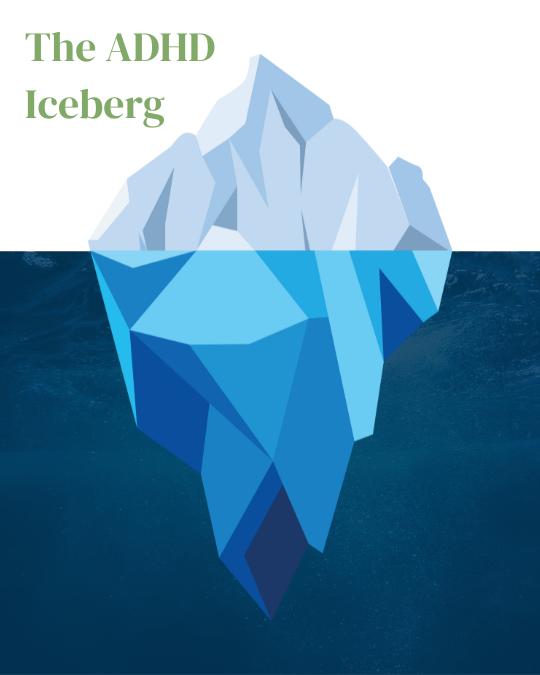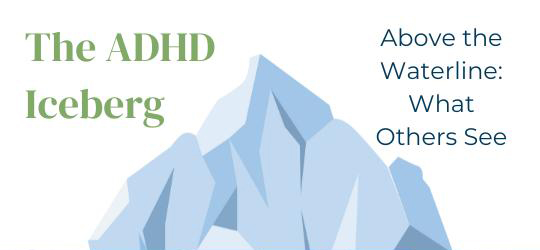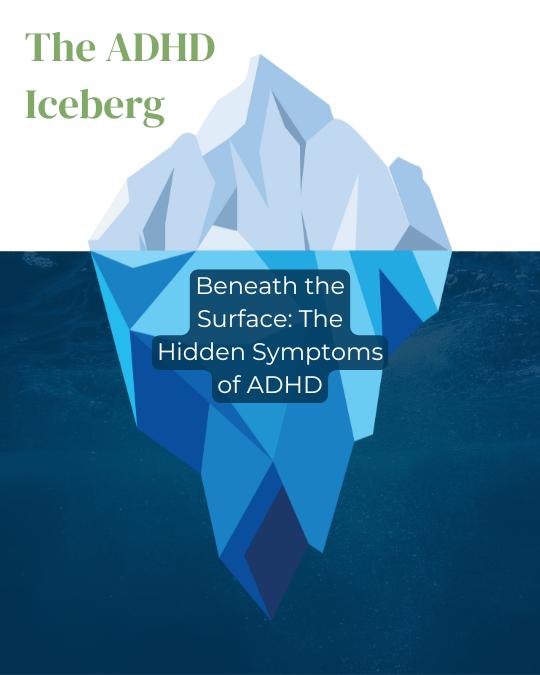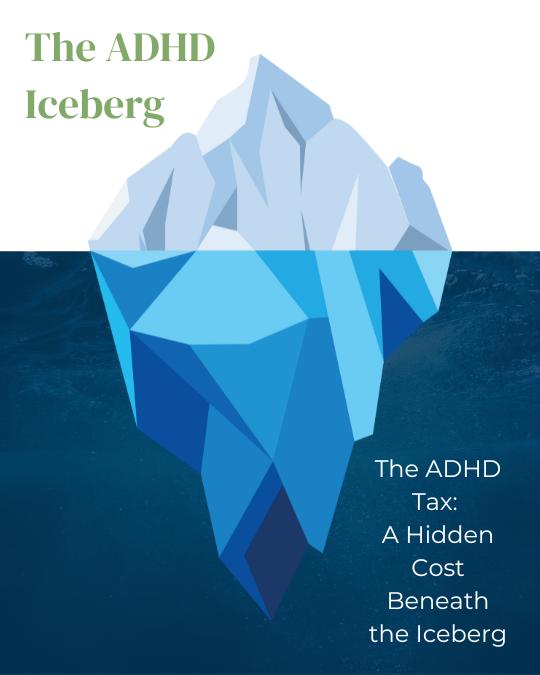When you think of ADHD, what comes to mind? For many, it’s the traits most often associated with childhood diagnoses: hyperactivity, inattentiveness, and impulsivity. These are the “above the waterline” symptoms of ADHD—the visible and outward signs that others can easily identify. But ADHD is much more than what meets the eye.

Like an iceberg, the majority of ADHD’s impact lies hidden beneath the surface, influencing thoughts, emotions, and behaviors in ways that are less obvious but no less significant. These hidden aspects—the struggles with emotional regulation, executive functioning, and self-esteem—are often overlooked, even by those living with ADHD. Yet, they profoundly affect how individuals navigate daily life, especially for adults juggling the demands of careers, families, and personal goals.
This “ADHD iceberg” metaphor captures the duality of the condition: what is seen and acknowledged versus what remains unseen but deeply felt. For adults with ADHD, understanding both the visible and hidden elements is crucial—not just for managing symptoms but also for cultivating self-compassion and building effective strategies to thrive.
In this post, we’ll dive beneath the surface of the ADHD iceberg to explore its layers. We’ll examine the external traits that often define ADHD, uncover the hidden challenges that shape daily experiences, and highlight the concept of the “ADHD tax,” which represents the tangible and intangible costs of living with this condition. By understanding what lies beneath, you’ll gain deeper insight into the full picture of ADHD and discover practical ways to navigate its complexities with confidence and strength.
Above the Waterline: What Others See of ADHD
The “above the waterline” symptoms of ADHD are external and observable—traits that often lead to a diagnosis, especially in childhood.

Hyperactivity
- Restlessness or constant motion, like fidgeting or tapping.
- Difficulty staying seated or a strong urge to move frequently.
- Often misunderstood as a lack of self-control or intentional disruption.
Inattention
- Trouble focusing on tasks, especially those perceived as uninteresting.
- A tendency to lose track of details, resulting in mistakes.
- Frequently misplacing items like keys or wallets, or forgetting appointments.
Impulsivity
- Interrupting conversations or acting without thinking.
- Difficulty waiting for a turn or rushing through tasks.
- Impulsive decisions, such as overspending or risky behaviors.
While these traits are the ones most commonly recognized, they only scratch the surface of the ADHD experience.
Beneath the Surface: The Hidden Symptoms of ADHD
What lies beneath the surface reveals the full complexity of living with ADHD. These hidden symptoms are often invisible to others but deeply influence daily life.

1. Emotional Regulation Challenges
- Intense emotional reactions to minor triggers, which may feel overwhelming.
- Difficulty calming down, leading to prolonged emotional distress.
- Rejection Sensitivity Dysphoria (RSD): An intense response to perceived criticism or rejection.
2. Executive Functioning Struggles
Executive functioning includes the mental skills needed to plan, organize, and execute tasks. ADHD significantly impacts these skills:
- Time Blindness: Losing track of time or misjudging how long tasks take.
- Task Initiation Problems: Struggling to start even important tasks.
- Organization Challenges: Difficulty maintaining order in physical or digital spaces.
Prioritization Confusion: Feeling paralyzed when deciding which task matters most.
3. Hyperfocus
A paradoxical symptom where individuals intensely concentrate on tasks they find stimulating, often at the expense of other responsibilities.
4. Chronic Overwhelm
- Feeling perpetually behind or unable to catch up.
- Managing multiple responsibilities without a clear system can lead to mental clutter.
5. Energy Regulation Issues
- Oscillating between bursts of energy and complete exhaustion.
- Struggling to pace oneself, often leading to burnout.

6. Sleep Difficulties
- Racing thoughts or difficulty winding down, making it hard to fall asleep.
- Inconsistent sleep patterns that worsen daytime ADHD symptoms.
7. Low Self-Esteem
- Years of struggling with ADHD-related challenges can erode confidence.
- Comparing oneself to neurotypical peers often leads to feelings of inadequacy.
8. Co-Occurring Conditions
Anxiety, depression, or learning disabilities frequently coexist with ADHD, compounding challenges.
The ADHD Tax: A Hidden Cost Beneath the Iceberg
The “ADHD tax” refers to the literal and figurative costs incurred due to ADHD symptoms. It represents how ADHD impacts finances, time, energy, and emotional well-being.

Financial Costs
- Late Fees and Missed Payments: Forgetting due dates or mismanaging bills can result in extra charges.
- Impulsive Spending: Buying items impulsively or overspending on unnecessary things.
- Repeated Purchases: Replacing lost or misplaced items frequently.
Time Costs
- Losing hours to distractions or hyperfocus on non-priority tasks.
- Spending extra time fixing avoidable mistakes due to inattentiveness or disorganization.
Emotional Costs
- The guilt and frustration of consistently “falling behind.”
- Strained relationships due to missed commitments or impulsive actions.
Career and Productivity Costs
- Missed opportunities or career stagnation due to procrastination or difficulty managing tasks.
Understanding and mitigating the ADHD tax requires awareness of its triggers and implementing systems to minimize its impact.
Strategies for Managing the ADHD Iceberg
1. Reduce the ADHD Tax
- Automate bill payments to avoid late fees.
- Use budgeting apps to track and limit spending.
- Create a designated place for frequently lost items to reduce replacement costs.
2. Externalize and Visualize
- Use planners, digital apps, or whiteboards to organize tasks and appointments.
- Develop visual cues, like labeled bins or sticky notes, to aid memory and reduce clutter.
3. Practice Emotional Regulation
- Mindfulness, grounding exercises, or therapy can help manage emotional dysregulation.
- Address RSD by identifying safe spaces or people to discuss feelings without fear of judgment.

4. Break Down and Simplify Tasks
- Divide overwhelming tasks into smaller, actionable steps.
- Use tools like timers (e.g., Pomodoro Technique) to structure work sessions.
5. Develop Supportive Routines
- Establish routines to reduce decision fatigue and create consistency.
- Incorporate rest and self-care to prevent burnout.
6. Optimize Your Environment
- Eliminate unnecessary distractions by setting up a dedicated workspace.
- Use tools like noise-canceling headphones or calming playlists.

7. Seek Support
- Connect with ADHD support groups or communities to share experiences and learn strategies.
- Work with an ADHD coach or therapist to create personalized systems.
8. Celebrate Strengths
- Recognize the unique strengths of ADHD, such as creativity, problem-solving, and resilience.
- Focus on achievements, however small, to build self-esteem.
Reframing the ADHD Iceberg
The ADHD iceberg metaphor reminds us that the most visible symptoms are just the tip of a much larger experience. While the hidden challenges can feel overwhelming, they also offer opportunities for growth, self-awareness, and connection with others who share similar struggles.
By addressing both the visible and hidden aspects of ADHD—and managing the ADHD tax—we can navigate life with greater ease and balance. ADHD isn’t just about the challenges; it’s also about the creativity, resourcefulness, and unique perspectives that come with neurodiversity.
Conclusion: Navigating the ADHD Iceberg with Strength and Strategy
Living with ADHD is less about erasing the iceberg and more about mastering the waters around it. Understanding the ADHD iceberg provides a powerful framework for embracing the complexities of ADHD, particularly for parents and professionals managing executive functioning challenges. By acknowledging not just the visible symptoms but also the hidden struggles beneath the surface, we create space for deeper self-awareness, compassion, and growth.
Life with ADHD can feel overwhelming at times, but it’s important to remember that challenges do not define your worth. Beneath the surface lies not just the struggles but also unique strengths—creativity, resilience, problem-solving abilities, and an unparalleled capacity for innovation. These qualities are as much a part of the ADHD iceberg as the difficulties, and learning to leverage them can transform how you approach both daily life and long-term goals.
The strategies outlined in this post—reducing the ADHD tax, externalizing tasks, fostering emotional regulation, building routines, and celebrating your strengths—are tools to help you rise above the challenges and unlock your potential. Every small step, from automating a task to practicing mindfulness, brings you closer to a life where ADHD works with you instead of against you.

For parents, this journey might mean modeling self-acceptance and building systems that support both your needs and those of your family. For professionals, it could involve integrating ADHD-friendly strategies into your work life to thrive in demanding environments. For everyone, it’s about giving yourself permission to grow, learn, and adapt without judgment.
Imagine the iceberg not just as a list of struggles but as a map to a greater understanding—of yourself, your needs, and your potential. By navigating the waters with patience, persistence, and support, you can uncover the beauty and strength hidden beneath the surface. Recognizing and managing the hidden costs of ADHD, like the ADHD tax, allows individuals to lead fulfilling and empowered lives, embracing both the challenges and opportunities ADHD presents.
ADHD doesn’t have to be the weight that pulls you under; it can be the foundation that helps you rise.
Learn more with Online Coaching for Executive Functioning / ADHD
Ready to gain control and enhance your executive functioning? As an experienced and compassionate coach, I specialize in providing support for executive functioning and ADHD. To embark on your journey, please reach out to me at 708-264-2899 or email hello@suzycarbrey.com to schedule a FREE 20-minute discovery call consultation.
With a background as a speech-language pathologist, I have a strong foundation in executive functioning coaching. My graduate degree program in SLP placed a significant emphasis on cognition, including executive functions, and I have years of experience in medical rehabilitation, providing cognitive-communication therapy. Additionally, I have completed an ADHD Services Provider certification program, I am Solutions-Focused Brief Therapy Diamond Level 1 certified and I am trained in the Seeing My Time® executive functioning curriculum.
Experience the convenience and effectiveness of online coaching, backed by studies that demonstrate equal results to in-person services. Parents, professionals, and emerging adults love the convenience and privacy of receiving coaching from their own homes.
Whether you reside in Chicago, Milwaukee, Indianapolis, Kansas City, or anywhere else around the globe, I am here to assist you. Schedule your discovery call consultation today, and I eagerly anticipate the opportunity to work with you!
Please note that although I am a certified speech-language pathologist, all services Suzy Carbrey LLC provides are strictly coaching and do not involve clinical evaluation or treatment services. If you require a formal speech therapy evaluation and treatment, please inform me, and I can provide appropriate recommendations.

